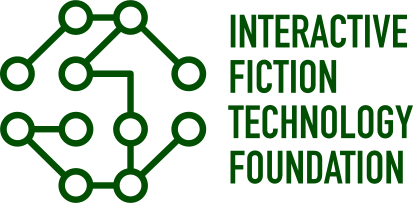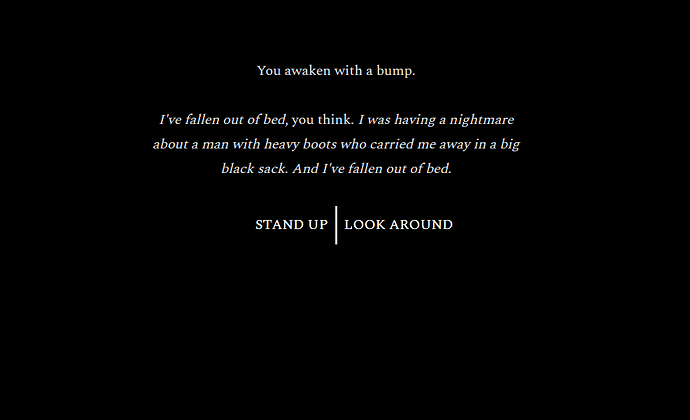This essay contains heavy spoilers for Bogeyman.
Bogeyman was a dark, disturbing Twine game with excellent production skills. It won the XYZZY Best Game award in 2018, up against games like Alias the Magpie, Cannery Vale and Cragne Manor, games that still have a strong following.
But Bogeyman beat them all. What did it do well?
Polish
There’s a double standard in IF where parser games can become extremely popular while looking like you opened up Notepad in 2003, but choice-based games are often judged by their physical appearance.
Highly-ranked choice-based games often include custom fonts and styling, music, character portraits, color changes, animations, etc. and many resources have developed to teach people these things (like Grim Baccaris’s Twine Grimoire).
Bogeyman has exceptional polish. It has music in the background, either several different tracks or one very long one, and it helps set the mood. The game has fading text transitions that are just long enough to be creepy but fast enough to not interrupt reading at all (a very narrow needle to thread). It uses a hand-picked font and arranges choices in a kind of 2 by 2 grid. It uses centered text and has a range of text variations (normal, italics, and fixed width) to communicate different voices.
It makes for a very effective presentation. If the game had used default Harlowe, it would still be a great game but lose a lot of its ‘punch’.
Gripping moral dilemma
Reading the postmortem of this game is very interesting. For background, you play as a child kidnapped by the literal bogeyman. He keeps five children at a time in his decaying wooden house, forcing them to do demeaning or dangerous chores. They have to eat disgusting food and thank him for it. But his true evil is that he pits you against each other.
In the postmortem, the author says about the Bogeyman:
Not to get heavy or anything, but I think he appeals to the frightened child in me because he’s an idealised version of an abuser. He’s cruel and unfair but at least he’s internally consistent. It’s a comforting myth among the abused and oppressed that if we could only be “good” enough, the punishment would stop. We’re desperate for authority figures who keep their promises, systems where pain happens for a reason and obedience really does guarantee safety. Living with an abuser isn’t really like that. “The Choice” is my attempt to find some kind of order in a harsh, confusing world.
The choice being referred to is the final choice of the game, but is also reflected in many smaller choices. If you snitch on your fellow kids, or show enthusiasm for their punishments, you are rewarded. If you help the kids, you are punished.
I found this setup to be very stressful and effective. This is not a feel-good game; I replayed it with trepidation, and had to take a while to stare into space after finishing it again.
The author points out that the game’s ending depends entirely on a single choice:
Some reviewers have complained about a single choice determining which ending you get, which is understandable. Personally I don’t think it’s fair to say all the choices leading up to that moment “don’t matter” – those earlier choices, those were the story!
I think this is still underselling the game’s responsiveness. Having played multiple times, I saw significant differences in the way the Bogeyman treated me and how other characters regarded me, what they confided in me.
The ending does erase all the past and bring things down to a single moment, but the other choices provide context for that moment.
Strong Writing
The choice structure above wouldn’t work at all without player investment. The writing here is what really shines. This game won not only Best Game at the XYZZYs but also Best Writing, Best Story, and Best Individual NPCs. The only writing-based award it didn’t receive was Best NPCs, but it was nominated.
The ambiguity is what helps a lot. No character is black and white. Tabitha is the most helpful and reassuring, but is also the most devious and rebellious. Humphrey is truly hateful, but is also a small child trying to survive. Grace is little and helpless, but her constant mishaps put everyone at risk. Peter is quiet but doesn’t always obey.
And the Bogeyman himself is cruel and loving at the same time. Like the postmortem says, he is an idealized abuser, one who is actually consistent, who will keep the rules he set out. His characterization rings unfortunately true for many who have been in an abusive situation.
Conclusion
In all years, the XYZZY Best Game is a game with a combination of what the community considers the best at fiction and the best at interactivity. It was up against some very strong competition in its year; but I think that it won because its interactivity is in direct service to its fiction. Each choice is there, not for window dressing, but because it forces you to be complicit in the story, giving you a real choice where both options have real arguments for their use, and real stakes.
It is the shortest XYZZY Winner, but, for me, not the easiest to finish.
Made with the support of the Interactive Fiction Technology Foundation

